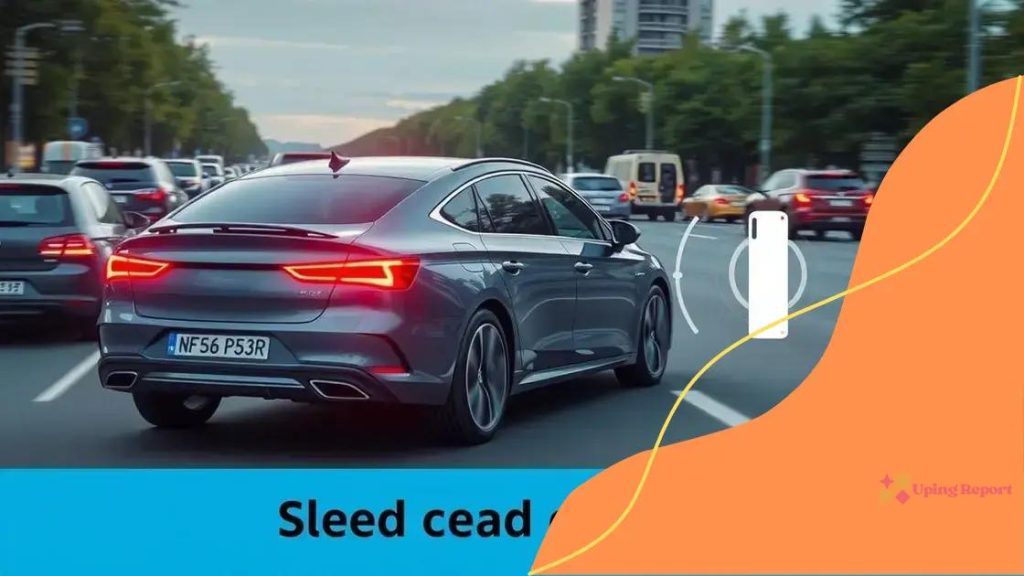WA mandates speed control tech: is your vehicle ready?

WA mandates speed control tech to enhance road safety, improve vehicle efficiency, and reduce accidents through features like automatic speed regulation and collision avoidance systems.
WA mandates speed control tech to improve road safety and efficiency. But what does this mean for both drivers and manufacturers? Exploring the implications can offer valuable insights.
Understanding WA’s speed control tech regulations
Understanding WA’s speed control tech regulations is essential for drivers and manufacturers alike. These regulations aim to enhance safety on the roads while ensuring that vehicles are equipped with the latest technology. It’s important for everyone to be informed about these rules.
The Importance of Speed Control Technology
Speed control technology helps to manage the speed of vehicles, reducing the risk of accidents. This technology can include features like automatic speed limiters and adaptive cruise control.
- Enhanced safety for all road users
- Reduced likelihood of speeding violations
- Improved overall traffic flow
As we dive deeper into these regulations, it’s clear that the benefits extend beyond just compliance. Developing an understanding of how these systems work can provide insights into their effectiveness. Installing and maintaining such technologies is not only vital for adhering to legal requirements but also for ensuring peace of mind while driving.
Key Regulations for Drivers
For drivers in WA, it is crucial to stay updated with the specific rules regarding speed control systems. These regulations may mandate the inclusion of specific technologies in new vehicles. Understanding these requirements can help you make informed choices when purchasing or upgrading vehicles.
- Knowledge of legal obligations can improve road awareness.
- Compliance can lead to fewer penalties and fines.
- Safety enhancements can reduce insurance costs.
As technology advances, so do the regulations surrounding it. Keeping abreast of changes ensures that you are prepared for the future of driving. Adapting to these advancements not only ensures compliance but also fosters a safer driving environment for everyone.
Manufacturer Responsibilities
Manufacturers have a critical role in meeting these regulations. They must ensure that their vehicles are equipped with the required speed control technologies before they hit the market. This responsibility includes rigorous testing and compliance with the latest safety standards. Failure to comply can lead to significant consequences for manufacturers, including penalties and potential recalls.
Moreover, educating consumers about these technologies can enhance user experience and promote safer driving habits. It’s essential for manufacturers to not only produce compliant vehicles but also to create awareness about the benefits of speed control technologies. This cooperation between drivers and manufacturers is crucial for the overall success of speed control regulations in WA.
Benefits of speed control technology in vehicles
The benefits of speed control technology in vehicles are numerous and significant. As more vehicles adopt these systems, drivers and passengers alike can enjoy a safer and more efficient journey. Understanding these advantages can help both consumers and manufacturers appreciate the value of this technology.
Enhanced Safety
One of the primary benefits of speed control technology is enhanced safety on the roads. By automatically adjusting speed, these systems help prevent accidents caused by speeding. For example, adaptive cruise control can maintain a safe distance from the car ahead, reducing the risk of collisions. With these technologies, drivers can focus more on the road rather than constantly monitoring their speed.
- Reduction in accidents caused by speeding
- Increased driver awareness
- Improved reaction times during emergencies
In addition to individual safety, these systems contribute to overall traffic safety, benefiting all road users, including pedestrians and cyclists.
Improved Fuel Efficiency
Beyond safety, speed control technology can also lead to improved fuel efficiency. Maintaining a constant speed reduces fuel consumption, as vehicles tend to use less gas when not frequently accelerating or braking. This advantage not only saves money for drivers but also helps to reduce emissions, contributing to a cleaner environment.
- Lower fuel costs per trip
- Decreased greenhouse gas emissions
- Longer vehicle lifespan due to reduced strain
By embracing speed control technology, drivers can make a positive impact on both their wallets and the planet.
Convenience and Comfort
Finally, the convenience and comfort offered by speed control technology cannot be overlooked. Features like cruise control and lane-keeping assistance allow drivers to relax on long trips, making journeys less tiring. The technology is designed to work seamlessly, requiring minimal input from the driver, which enhances the overall driving experience.
As drivers adapt to these systems, they may find that they feel more confident and secure on the road. This confidence can encourage safer driving habits, further amplifying the benefits of speed control technology.
Challenges faced by automakers

Automakers face several challenges when it comes to integrating speed control technology into their vehicles. These challenges can impact production timelines and customer satisfaction. Understanding these hurdles is vital for both the industry and consumers.
Regulatory Compliance
One significant challenge is ensuring compliance with evolving regulations. As governments implement stricter laws regarding speed control technology, manufacturers must adapt their practices. Navigating these regulations can add complexity and cost to the manufacturing process.
- Keeping up with changing laws can strain resources.
- Cost of compliance can affect vehicle pricing.
- Failure to comply may lead to penalties and recalls.
Being proactive in understanding and meeting these requirements is essential for automakers. They need to invest time and money into research and development to ensure their vehicles comply with the latest standards.
Market Competition
The automotive market is highly competitive, pushing manufacturers to innovate rapidly. Automakers must not only focus on implementing speed control technology but also on improving other features, which can be overwhelming. With many players in the market, standing out is crucial for success.
In this environment, pressure to deliver advanced technology while keeping costs down can hinder development.
- Meeting consumer expectations for safety and efficiency.
- Balancing innovation with affordability.
- Competing for market share in an evolving landscape.
Staying ahead in technology is more than just about speed control; it encompasses a range of advanced features that enhance overall vehicle performance. This dynamic requires manufacturers to constantly innovate while managing their resources effectively.
Consumer Acceptance
Finally, consumer acceptance of speed control technology presents another challenge. Many drivers might be hesitant to embrace new systems due to fear or misunderstanding. Education is vital in helping consumers recognize the safety and efficiency benefits that these technologies provide.
Automakers need to invest in marketing and informational campaigns to alleviate concerns and promote the advantages of speed control technology. Building trust and familiarity with technology will encourage wider adoption among consumers.
How speed control tech enhances road safety
Speed control technology plays a vital role in enhancing road safety. By regulating vehicle speeds, these systems help prevent accidents and protect both drivers and pedestrians. Understanding how this technology works can provide deeper insights into its importance on our roads.
Automatic Speed Regulation
One of the core features of speed control technology is automatic speed regulation. This system can detect the speed limit on the road and adjust the vehicle’s speed accordingly. For instance, if a vehicle enters a zone with a lower speed limit, the technology can automatically reduce speed, minimizing the risk of speeding violations and associated accidents.
- Helps drivers adhere to speed limits
- Reduces the likelihood of traffic violations
- Improves overall traffic flow
As more vehicles adopt this technology, traffic incidents due to speeding can significantly decrease. This advancement not only benefits individual drivers but also improves community safety as a whole.
Collision Avoidance Systems
Speed control technology is often integrated with advanced collision avoidance systems. These systems use sensors to monitor the distance between vehicles. When a potential collision is detected, the system can automatically reduce speed or apply brakes, providing an extra layer of safety.
The integration of speed control with collision avoidance has proven to be effective in reducing accidents. Many modern vehicles come equipped with these features, enhancing the confidence of drivers on busy roads.
- Active protection from rear-end collisions
- Support for emergency stops
- Improved reaction times in critical situations
By working together, these technologies help create a safer driving environment, allowing drivers to feel more secure behind the wheel.
Promoting Safe Driving Behavior
Another way that speed control technology enhances road safety is by promoting safer driving behavior. Many systems provide feedback to drivers about their speed. When drivers receive real-time alerts or notifications about their speed, they are more likely to adjust their driving habits accordingly.
This feedback loop encourages drivers to be more conscious of their speed and the rules of the road. Over time, this can lead to a culture of safer driving, fostering a more responsible community of road users.
Future trends in automotive technology
Future trends in automotive technology are shaping the way we drive and interact with our vehicles. As technology evolves, so too do the features that enhance safety, efficiency, and convenience on the roads. Understanding these trends is key to anticipating the future of transportation.
Electrification of Vehicles
One major trend is the electrification of vehicles. Electric vehicles (EVs) are becoming more popular as technology improves and concerns about environmental impact grow. With government incentives and an expanding charging infrastructure, consumers are increasingly choosing EVs over traditional gasoline-powered cars.
- Reduced carbon emissions contribute to a cleaner environment.
- Lower operating costs due to less maintenance and fuel expenses.
- Advancements in battery technology increasing range and efficiency.
This shift not only benefits individual drivers but also has a positive impact on the automotive industry as a whole, pushing for innovation and sustainable practices.
Autonomous Driving Technology
Another significant trend is the development of autonomous driving technology. Companies are investing heavily in research and development to create fully self-driving vehicles. This technology promises to revolutionize how we think about travel and transportation.
Many vehicles already feature partial automation, such as lane-keeping assistance and adaptive cruise control. As these systems become more sophisticated, the potential for completely autonomous vehicles grows.
- Increased safety by reducing human error.
- Enhanced convenience for daily commutes.
- Improved mobility for individuals unable to drive.
The transition to autonomy is expected to reshape urban planning and transportation systems, creating opportunities for new mobility solutions.
Connected Vehicle Technologies
Connected vehicle technologies are also on the rise, enabling vehicles to communicate with each other and infrastructure. This connectivity helps improve traffic flow and enhance safety by providing real-time data to drivers and systems.
Examples include vehicle-to-vehicle (V2V) and vehicle-to-infrastructure (V2I) communication. These technologies can alert drivers to potential hazards or traffic conditions, allowing for better decision-making behind the wheel.
- Increased situational awareness for drivers.
- Improved response times to traffic changes.
- Greater overall road safety through data sharing.
The future of automotive technology is exciting and full of potential. As advances continue to be made, we can expect a transportation landscape that prioritizes safety, efficiency, and sustainability.
FAQ – Frequently Asked Questions about Automotive Technology
What are the main benefits of electric vehicles?
Electric vehicles reduce carbon emissions, lower operating costs, and often require less maintenance compared to traditional cars.
How does autonomous driving technology improve safety?
Autonomous driving technology significantly reduces human error, which is a major cause of traffic accidents.
What is connected vehicle technology?
Connected vehicle technology enables cars to communicate with each other and with infrastructure, improving traffic flow and safety.
How can speed control technology promote safe driving?
Speed control technology helps drivers adhere to speed limits and can provide feedback to encourage safer driving habits.
